The Impact of Objects with a Potential Odour Nuisance on the Life Comfort of the Urban Agglomeration Inhabitants
Abstract
1. Introduction
1.1. Literature Review
- Fuels (motor gasoline, diesel and distillates, liquefied petroleum gas, jet fuel, fuel oil residues, naphtha, and coke);
- Finished non-fuel products (solvents, lubricating oils, greases, kerosene wax, jelly, asphalt, and coke);
- Chemical raw materials (diesel, ethane, propane, butane, ethylene, propylene, butylene, butadiene, butadiene, toluene, xylene).
1.2. Bibliometric Analysis
- Frasnelli and Hummel (2005) [48]—cited by 226 authors; paper and pencil questionnaire.
- Bartha et al. (1999) [49]—cited by 179 authors; paper and pencil questionnaire.
- Hillert et al. (2002) [50]—cited by 119 authors; e-mail questionnaire.
- Brancher et al. (2002) [51]—cited by 112 authors.
- Hayes et al. (2014) [52]—cited by 84 authors.
- Merkonidis et al. (2015) [53]—cited by 47 authors; paper and pencil questionnaire.
- Ames et al. (1993) [54]—cited by 36 authors; paper and pencil questionnaire.
2. Materials and Methods
2.1. Characteristics of the Agglomeration Under Consideration
2.2. Previous Studies on Air Pollution
2.3. Surveys
- 1.
- Subjectivity in odour perception and response
- Individual differences: People respond differently to the same odours due to variations in olfactory sensitivity, personal preferences, or past experiences with certain odours.
- Diverse interpretive standards: Terms like “intensity” or “hedonic quality” may be interpreted differently by respondents, leading to inconsistent responses.
- 2.
- Timing and location of survey administration
- Variable atmospheric conditions: Wind speed and direction, temperature, and humidity can impact odour dispersion and, therefore, influence perceived odour intensity.
- Temporal comparability: Conducting surveys on different days or at various times of day can lead to varying responses due to changes in odour intensity. Odor conditions may differ in the morning, evening, or on weekends when urban traffic patterns vary.
- 3.
- Respondent location within the agglomeration
- Proximity to odour sources: Respondents situated at different distances from odour sources may perceive varying levels of intensity, potentially affecting survey outcomes.
- Local environmental conditions: Buildings, terrain topography, and local infrastructure can alter airflow and odour distribution within the city.
- 4.
- Social and cultural factors
- Influence of social opinion: Respondents may be swayed by the views of neighbours, media reports, or local discussions, impacting their odour assessments.
- Social norms and expectations: In large agglomerations, tolerance for industrial or urban odours may vary depending on social status or quality of life expectations.
- 5.
- Question formulation in the survey
- Ambiguous wording: Questions may be interpreted differently by respondents, particularly when addressing subjective concepts such as “hedonic quality”.
- Suggestion effect: Question phrasing or placement within the survey may affect responses by implying an expected range of odour intensity or quality.
- Standardisation of the questionnaire and instructions—clear definitions of terms: we explained terms such as “intensity” and “hedonic quality” of odour to ensure that all respondents interpreted them consistently. We provided clear guidelines for odour assessment to minimise individual interpretive differences.
- Use of subjective rating scales and quality indicators with descriptive, well-defined scales, which are easier to understand and allow for response standardisation.
- Control of survey location: questions about weather conditions as well as location of odour nuisance.
- Minimising the impact of social and cultural factors: ensuring response anonymity to reduce the influence of social norms and social pressure on respondents’ answers.
2.4. Residents’ Complaints
2.5. Statistical Analysis of the Results Obtained
3. Results and Discussion
3.1. Analysis of Previous Study Results
3.2. Analysis of Residents’ Complaints
3.3. Analysis of Survey Results
3.4. Statistical Analysis of Survey Results
- -
- No homogeneity correction: F factor = 2.684, p = 0.010, size of effect: η2 = 0.029, ϖ2 = 0.018;
- -
- Brown–Forsythe homogeneity correction: F factor = 2.752, p = 0.008, size of effect: η2 = 0.029, ϖ2 = 0.018;
- -
- Welch homogeneity correction: F factor = 3.544, p = 0.001, size of effect: η2 = 0.029, ϖ2 = 0.018.
- -
- No homogeneity correction: F factor = 1.643, p = 0.121, size of effect: η2 = 0.018, ϖ2 = 0.007;
- -
- Brown–Forsythe homogeneity correction: F factor = 1.640, p = 0.122, size of effect: η2 = 0.018, ϖ2 = 0.007;
- -
- Welch homogeneity correction: F factor = 1.597, p = 0.138, size of effect: η2 = 0.018, ϖ2 = 0.007.
4. Conclusions
Author Contributions
Funding
Institutional Review Board Statement
Informed Consent Statement
Data Availability Statement
Conflicts of Interest
References
- Shanahan, L.K.A.; Gottfried, J. Olfactory insights into sleep-dependent learning and memory. Prog. Brain Res. 2014, 208, 309–343. [Google Scholar] [CrossRef] [PubMed]
- Wypych, G. Front matter. In Handbook of Odors in Plastic Materials, 2nd ed.; Elsevier: Amsterdam, The Netherlands, 2017. [Google Scholar]
- Wu, Y.; Lin, H.; Yin, W.; Shao, S.; Lv, S.; Hu, Y. Water Quality and Microbial Community Changes in an Urban River after Micro-Nano Bubble Technology in Situ Treatment. Water 2019, 11, 66. [Google Scholar] [CrossRef]
- Wiśniewska, M.; Kulig, A.; Lelicińska-Serafin, K. Odour Load of Selected Elements of the Technological Line at a Municipal Waste Biogas Plant. Energies 2022, 15, 2427. [Google Scholar] [CrossRef]
- Wojnarowska, M.; Sołtysik, M.; Sagan, A.; Stobiecka, J.; Plichta, J.; Plichta, G. Impact of Odor Nuisance on Preferred Place of Residence. Sustainability 2020, 12, 3181. [Google Scholar] [CrossRef]
- Capelli, L.; Sironi, S.; Del Rosso, R.; Guillot, J.M. Measuring odours in the environment vs dispersion modelling: A review. Atmos. Environ. 2013, 79, 731. [Google Scholar] [CrossRef]
- Chen, C.L.; Shu, C.M.; Fang, H.Y. Location and Characterisation of Emission Sources for Airborne Volatile Organic Compounds Inside a Refinery in Taiwan. Environ. Monit. Assess. 2016, 120, 487. [Google Scholar] [CrossRef]
- Davoli, E.; Gangai, M.L.; Morselli, L.; Tonelli, D. Characterisation of odorants emissions from landfills by SPME and GC/MS. Chemosphere 2003, 51, 357. [Google Scholar] [CrossRef]
- De Santis, F.; Fino, A.; Menichelli, S.; Vazzana, C.; Allegrini, I. Monitoring the air quality around an oil refinery through diffusive sampling. Anal. Bioanal. Chem. 2004, 378, 782. [Google Scholar] [CrossRef]
- Mazur-Wierzbicka, E. Towards Circular Economy—A Comparative Analysis of the Countries of the European Union. Resources 2021, 10, 49. [Google Scholar] [CrossRef]
- Santoyo-Castelazo, E.; Azapagic, A. Sustainability assessment of energy systems: Integrating environmental, economic and social aspects. J. Clean. Prod. 2014, 80, 119–138. [Google Scholar] [CrossRef]
- Wiśniewska, M.; Kulig, A.; Lelicińska-Serafin, K. Odour Nuisance at Municipal Waste Biogas Plants and the Effect of Feedstock Modification on the Circular Economy—A Review. Energies 2022, 14, 6470. [Google Scholar] [CrossRef]
- Zhou, Z.; Tang, Y.; Chi, Y.; Ni, M.; Buekens, A. Waste-to-energy: A review of life cycle assessment and its extension methods. Waste Manag. Res. 2018, 36, 3–16. [Google Scholar] [CrossRef] [PubMed]
- Eltarkawe, M.A.; Miller, S.L. The impact of industrial odors on the subjective well-being of communities in Colorado. Int. J. Environ. Res. Public Health 2018, 15, 1091. [Google Scholar] [CrossRef] [PubMed]
- Luginaah, I.; Taylor, S.M.; Elliott, S.J.; Eyles, J.D. Community reappraisal of the perceived health effects of a petroleum refinery. Soc. Sci. Med. 2022, 55, 47–61. [Google Scholar] [CrossRef]
- Sówka, I.; Bezyk, Y.; Grzelka, A.; Miller, U.; Pachurka, Ł. Seasonal odour impact range of selected wastewater treatment plants—Modeling studies using Polish reference model. Water Sci. Technol. 2017, 2018, 422–429. [Google Scholar] [CrossRef]
- Steinheider, B.; Winneke, G.; Schlipkoter, H.W. Somatic and psychological effects of malodour: A case study from a mushroom fertilizer production plant. Staub Reinhalt. Der Luft 1993, 53, 425–431. [Google Scholar]
- Weisel, K.K.; Fuhrmann, L.M.; Berking, M.; Baumeister, H.; Cuijpers, P.; Ebert, D.D. Standalone smartphone apps for mental health—A systematic review and meta-analysis. npj Digit. Med. 2019, 2, 118. [Google Scholar] [CrossRef]
- Wang, X. Odour concentrations in natural ventilated pig sheds in Australia. In Air Pollution from Agricultural Operations III; American Society of Agricultural and Biological Engineers: St. Joseph, MI, USA, 2003; pp. 311–317. [Google Scholar] [CrossRef]
- Liang, Y.-X.; Su, Z.; Wu, W.-A.; Lu, B.-Q.; Fu, W.-Z.; Yang, L.; Gu, J.-Y. New trends in the development of occupational exposure limits for airbone chemicals in China. Regul. Toxicol. Phermacology 2003, 38, 112–123. [Google Scholar] [CrossRef]
- Cetin, E.; Odabasi, M.; Seyfioglu, R. Ambient volatile organic compound (VOC) concentrations around a petrochemical complex and a petroleum refinery. Sci. Total Environ. 2003, 312, 103–112. [Google Scholar] [CrossRef]
- Kalabokas, P.D.; Hatzaianestis, J.; Bartzis, J.G.; Papagiannakopoulos, P. Atmospheric concentrations of saturated and aromatic hydrocarbons around a Greek oil refinery. Atmos. Environ. 2001, 35, 2545–2555. [Google Scholar] [CrossRef]
- Crosby, D.G. Environmental Toxicology and Chemistry; Oxford University Press: New York, NY, USA, 1998. [Google Scholar]
- Environmental Protection Agency. EPA’s Environmental Justice for Strategy; Environmental Protection Agency: Parramatta, Australia, 1995. [Google Scholar]
- Buonicare, A.J.; Davis, W.T. Air Pollution Engineering Manual; Air and Waste Management Association: New York, NY, USA, 1992. [Google Scholar]
- Song, J.; Fan, H.; Gao, M.; Xu, Y.; Ran, M.; Liu, X.; Guo, Y. Toward High-Performance Map-Recovery of Air Pollution UsingMachine Learning. ACS EST Engg. 2023, 3, 73–85. [Google Scholar] [CrossRef]
- Boers, D.; Geelen, L.; Erbrink, H.; Smit, L.A.; Heederik, D.; Hooiveld, M.; Yzermans, C.J.; Huijbregts, M.; Wouters, I.M. The relation between modeled odor exposure from livestock farming and odor annoyance among neighboring residents. Int. Arch. Occup. Environ. Health 2016, 89, 521–530. [Google Scholar] [CrossRef] [PubMed]
- Cervinka, R.; Neudorfer, E. Coping strategies for coping with odor nuisance. Case study and follow-up. In Smells in the Environment. Indoor and Outdoor Air; VDI Verlag GmbH: Düsseldorf, Germany, 2007; pp. 149–161. [Google Scholar]
- Invernizzi, M.; Capelli, L.; Sironi, S. Proposal of odor nuisance index as urban planning tool. Chem. Senses 2017, 42, 105–110. [Google Scholar] [CrossRef] [PubMed]
- Badach, J.; Kolasińska, P.; Paciorek, M.; Wojnowski, W.; Dymerski, T.; Gębicki, J.; Dymnicka, M.; Namieśnik, J. A case study of odour nuisance evaluation in the context of integrated urban planning. J. Environ. Manag. 2018, 213, 417–424. [Google Scholar] [CrossRef] [PubMed]
- Brattoli, M.; de Gennaro, G.; de Pinto, V.; Loiotile, A.D.; Lovascio, S.; Penza, M. Odour detection methods: Olfactometry and chemical sensors. Sensors 2011, 11, 5290–5322. [Google Scholar] [CrossRef]
- Sironi, S.; Capelli, L.; Céntola, P.; Del Rosso, R.; Pierucci, S. Odour impact assessment by means of dynamic olfactometry, dispersion modelling and social participation. Atmos. Environ. 2010, 44, 354–360. [Google Scholar] [CrossRef]
- Wiśniewska, M.; Kulig, A.; Lelicińska-Serafin, K. The Use of Chemical Sensors to Monitor Odour Emissions at Municipal Waste Biogas Plants. Appl. Sci. 2021, 11, 3916. [Google Scholar] [CrossRef]
- Estrada, J.M.; Lebrero, R.; Quijano, G.; Kraakman, N.J.R.; Munoz, R. Strategies for odour control. In Odour Impact Assessment Handbook; John Wiley & Sons, Ltd.: Hoboken, NJ, USA, 2012; pp. 85–124. [Google Scholar] [CrossRef]
- Tyndall, J.; Colletti, J. Mitigating swine odor with strategically designed shelterbelt systems: A review. Agrofor. Syst. 2007, 69, 45–65. [Google Scholar] [CrossRef]
- Marquès, M.; Domingo, J.L.; Nadal, M.; Schuhmacher, M. Health risks for the population living near petrochemical industrial complexes. 2. Adverse health outcomes other than cancer. Sci. Total Environ. 2020, 730, 139122. [Google Scholar] [CrossRef]
- Song, J.; Stettler, M.E.J. A novel multi-pollutant space-time learning network for air pollution inference. Sci. Total Environ. 2022, 811, 1522554. [Google Scholar] [CrossRef]
- Bax, C.; Sironi, S.; Capelli, L. How Can Odors Be Measured? An Overview of Methods and Their Applications. Atmosphere 2020, 11, 92. [Google Scholar] [CrossRef]
- Brancher, M.; de Melo Lisboa, H. Odour impact assessment by community survey. Chem. Eng. Trans. 2014, 40, 139–144. [Google Scholar] [CrossRef]
- Hayes, J.E.; Stevenson, R.J.; Stuetz, R.M. Survey of the effect of odour impact on communities. J. Environ. Manag. 2017, 204, 349–354. [Google Scholar] [CrossRef] [PubMed]
- Conti, C.; Guarino, M.; Bacenetti, J. Measurements techniques and models to assess odor annoyance: A review. Environ. Int. 2020, 134, 10526. [Google Scholar] [CrossRef]
- Damuchali, A.M.; Huiging, G. Evaluation of odour properties, their relationships, and impact of an oil refinery plant on the surrounding environment using field measurements. Atmos. Environ. 2020, 230, 117480. [Google Scholar] [CrossRef]
- Dentoni, L.; Capelli, L.; Sironi, S.; Guillot, J.M.; Rossi, A.N. Comparison of different approaches for odour impact assessment: Dispersion modelling (CALPUFF) vs field inspection (CEN/TC 264). Water Sci. Technol. 2013, 68, 1731–1738. [Google Scholar] [CrossRef]
- Eyckmans, J.; De Jaeger, S.; Rousseau, S. Hedonic Valuation of Odor Nuisance Using Field Measurements: A Case Study of an Animal Waste Processing Facility in Flanders. Land Econ. 2013, 89, 53–75. [Google Scholar] [CrossRef]
- Oiamo, T.H.; Luginaah, I.N.; Baxter, J. Cumulative effects of noise and odour annoyances on environmental and health related quality of life. Soc. Sci. Med. 2015, 146, 191–203. [Google Scholar] [CrossRef]
- Sówka, I.; Pachurka, Ł.; Bezyk, Y.; Grzelka, A.; Miller, U. Application of field studies and geostatistical methods in assessment of odour nuisance based on selected examples from municipal, industrial and agricultural environments. Environ. Prot. Nat. Resour. 2017, 28, 16–21. [Google Scholar] [CrossRef][Green Version]
- Olson, K.; Smyth, J.D.; Horwitz, R.; Keeter, S.; Lesser, V.; Marken, S.; Mathiowetz, N.A.; McCarthy, J.S.; O’Brien, E.; Opsomer, J.D.; et al. Transitions from Telephone Surveys to Self-Administered and Mixed-Mode Surveys: AAPOR Task Force Report. J. Surv. Stat. Methodol. 2020, 9, 381–411. [Google Scholar] [CrossRef]
- Frasnelli, J.; Hummel, T. Olfactory dysfunction and daily life. Eur. Arch. Otorhinolaryngol. 2005, 262, 231–235. [Google Scholar] [CrossRef] [PubMed]
- Bartha, L.; Baumzweiger, W.; Buscher, D.S. Multiple chemical sensitivity: A 1999 consensus (1999). Arch. Environ. Health 1999, 54, 147–149. [Google Scholar] [CrossRef]
- Hillert, L.; Berglind, N.; Arnetz, B.B.; Bellander, T. Prevalence of self-reported hypersensitivity to electric or magnetic fields in a population-based questionnaire survey. Scand. J. Work Environ. Health. 2002, 28, 33–41. [Google Scholar] [CrossRef] [PubMed]
- Brancher, M.; Griffiths, K.D.; Franco, D.; de Melo Lisboa, H. A review of odour impact criteria in selected countries around the world. Chemosphere 2017, 168, 1531–1570. [Google Scholar] [CrossRef]
- Hayes, J.E.; Stevenson, R.J.; Stuetz, R.M. The impact of malodour on communities: A review of assessment techniques. Sci. Total Environ. 2014, 500, 395–407. [Google Scholar] [CrossRef]
- Merkonidis, C.; Grosse, F.; Ninh, T.; Hummel, C.; Haehner, A.; Hummel, T. Characteristics of chemosensory disorders--results from a survey. Eur. Arch. Otorhinolaryngol. 2015, 272, 1403–1416. [Google Scholar] [CrossRef]
- Ames, R.G.; Howd, R.A.; Doherty, L. Community exposure to a paraquat drift. Arch. Environ. Health 1993, 48, 47–52. [Google Scholar] [CrossRef]
- Available online: https://mojemiasto.plock.eu/ (accessed on 13 October 2023).
- Central Statistical Office. Statistical Vademecum of Regional Civil Servant; Central Statistical Office: New Delhi, India, 2020. [Google Scholar]
- Płock City Hall. Environmental Protection Programme for the Płock City. 2016. Available online: http://dane.plock.eu/bip//dane/uchwaly/projekty/vii/25/439/druk%20439%20Program%20Ochr.%C5%9Arod.-3.pdf (accessed on 21 August 2024).
- Wiśniewska, M.; Kulig, A. Concept of Questionnaire Surveys in an Urban Agglomeration as an Essential Element of Identifying the Sources of Odour Nuisance. Chem. Eng. Trans. 2022, 95, 199–204. [Google Scholar] [CrossRef]
- Available online: https://czysty.plock.eu/attachments/article/752/18.%20raport-z-pomiarow-plock%202022.pdf (accessed on 13 October 2023).
- Guidance on the Annexes to Decision 97/101/EC of Exchange of Information as revised by Decision 2001/752/EC. Available online: https://nilu.com/publication/13024/ (accessed on 21 August 2024).
- Official Journal of the European Union. Directive on Ambient Air Quality and Cleaner Air for Europe (2008/50/EC); Official Journal of the European Union: Princeton, NJ, USA, 2008. [Google Scholar]
- Ministry of the Environment. Regulation of the Environment Minister of January 26, 2010 on Reference Values for Certain Substances in the Air. Available online: https://isap.sejm.gov.pl/isap.nsf/DocDetails.xsp?id=wdu20100160087 (accessed on 21 August 2024). (In Polish)
- Wiśniewska, M.; Kulig, A.; Lelicińska-Serafin, K. Odour Emissions of Municipal Waste Biogas Plants—Impact of Technological Factors, Air Temperature and Humidity. Appl. Sci. 2020, 10, 1093. [Google Scholar] [CrossRef]
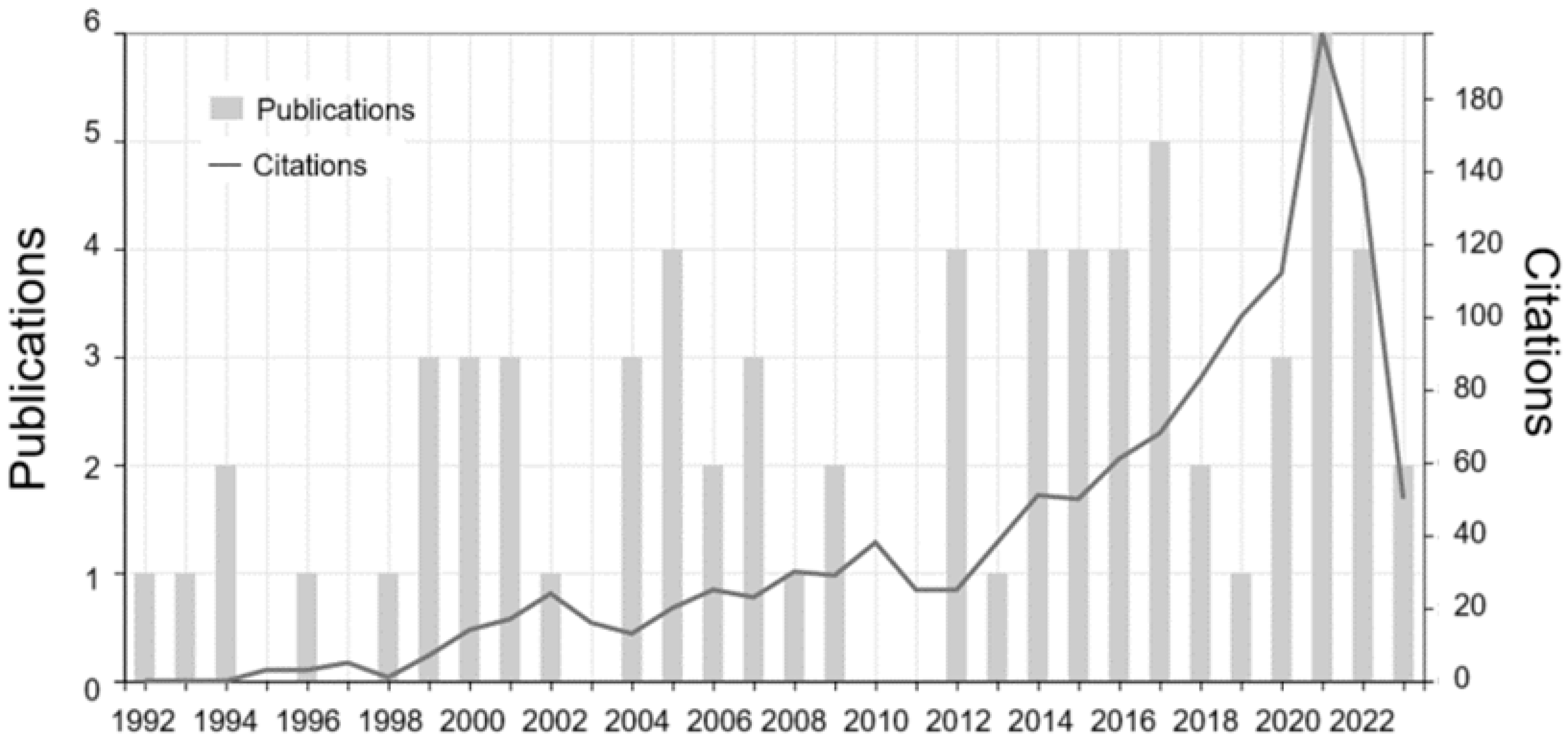

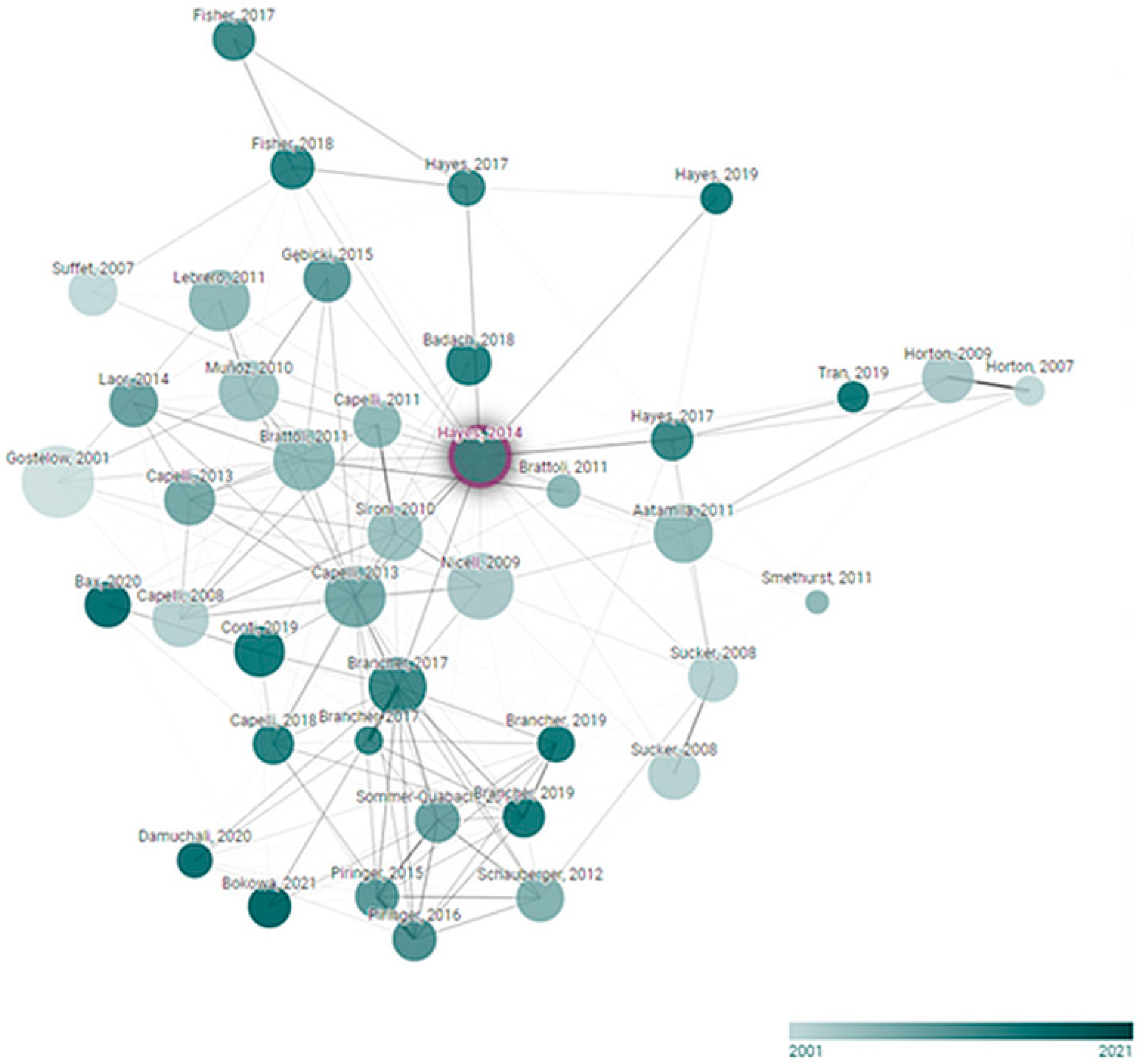
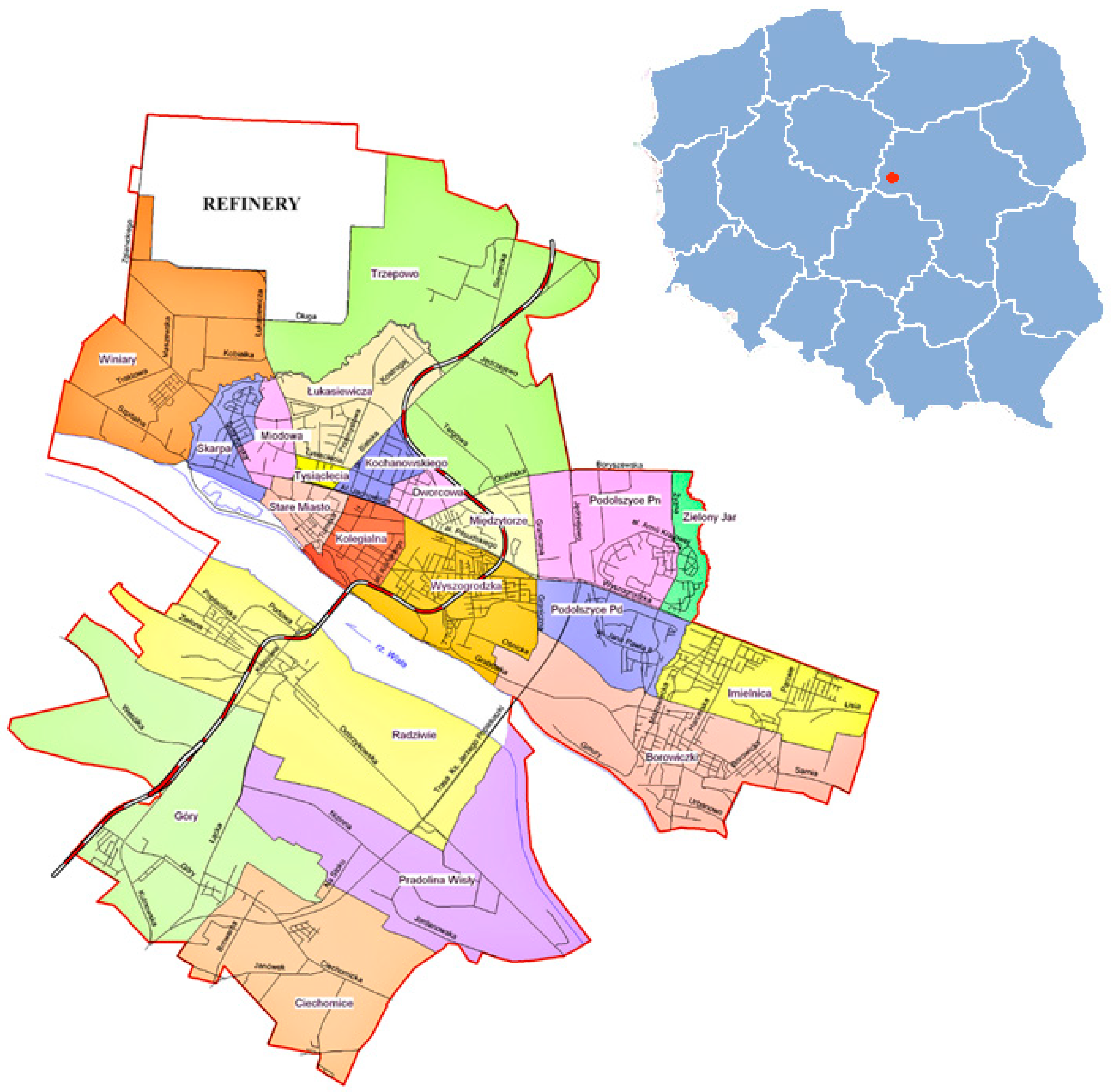



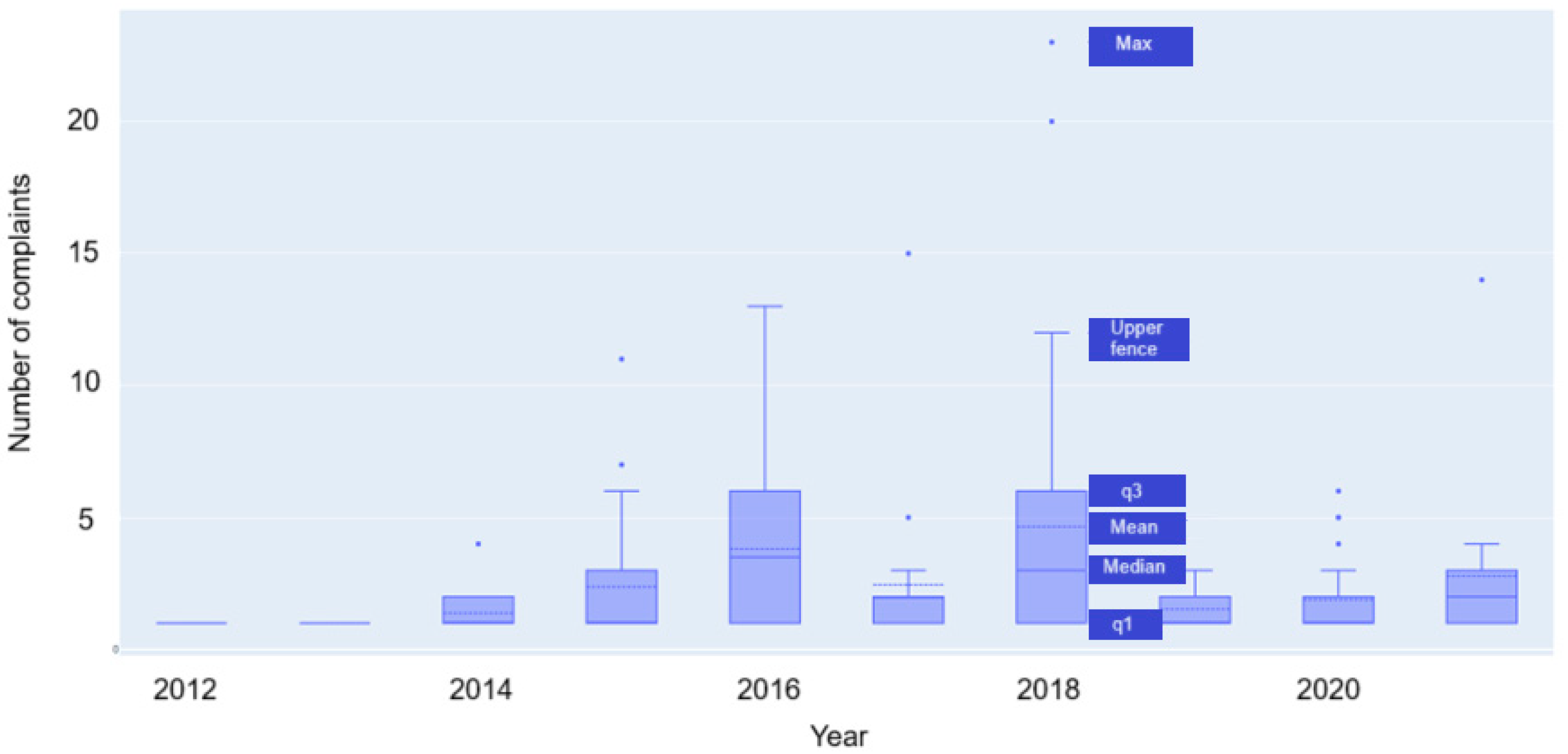


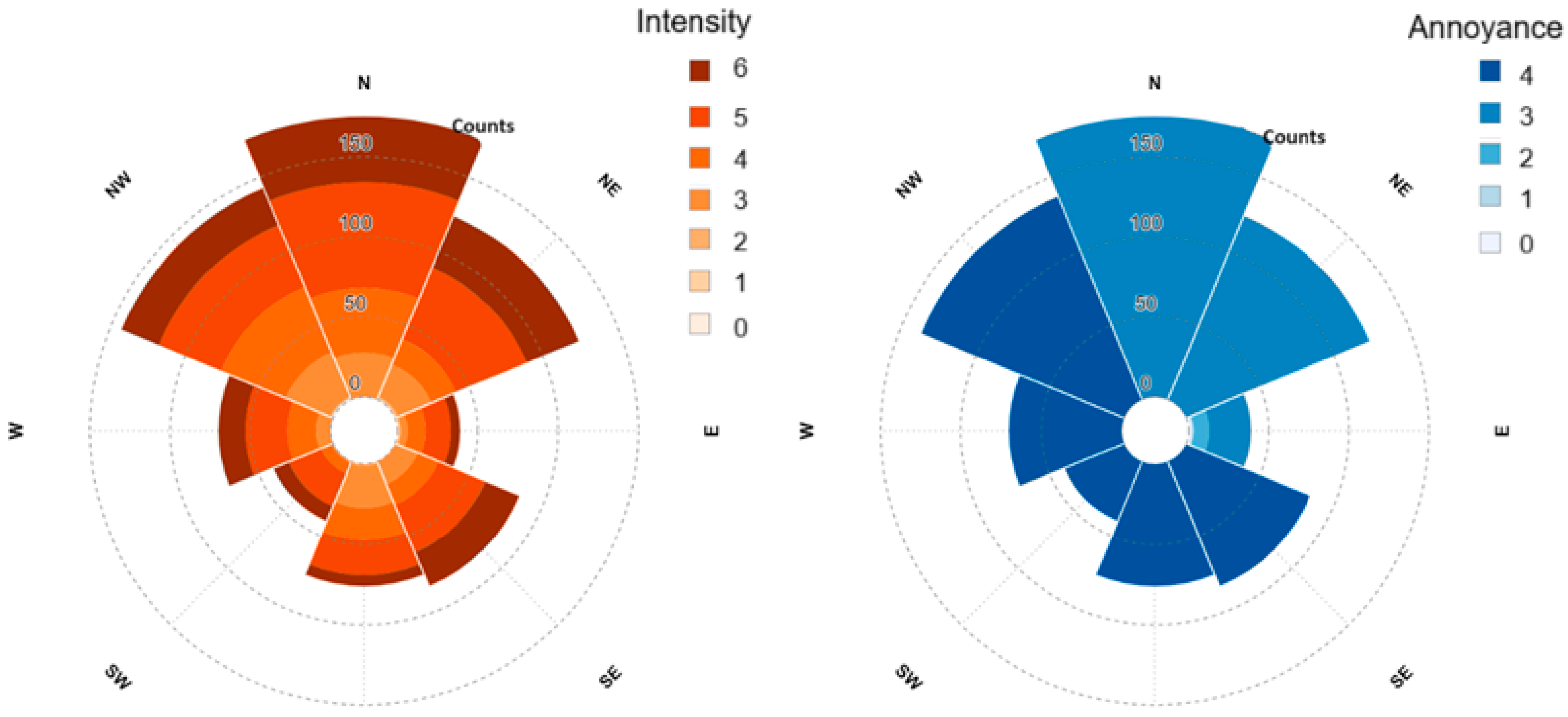
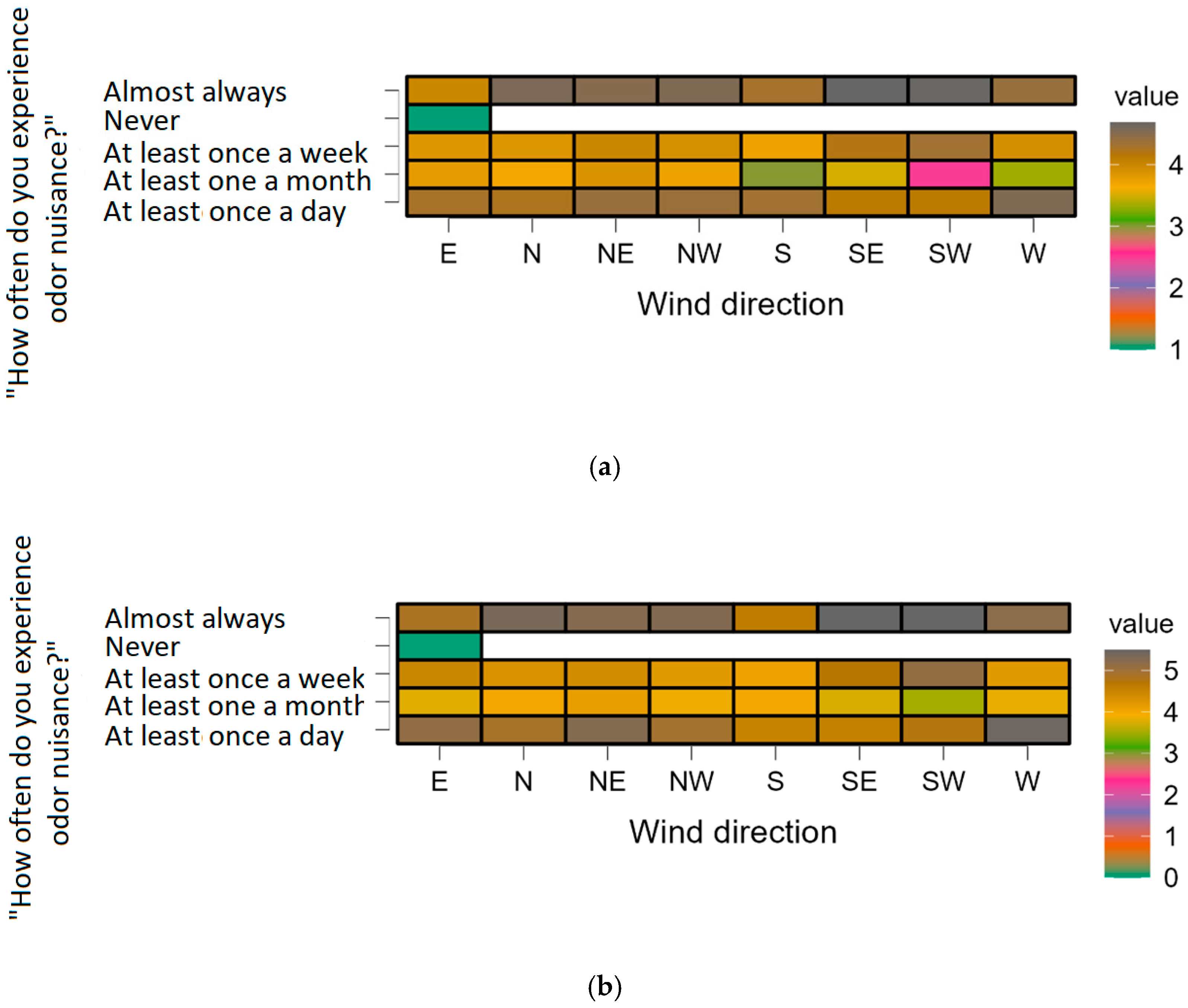
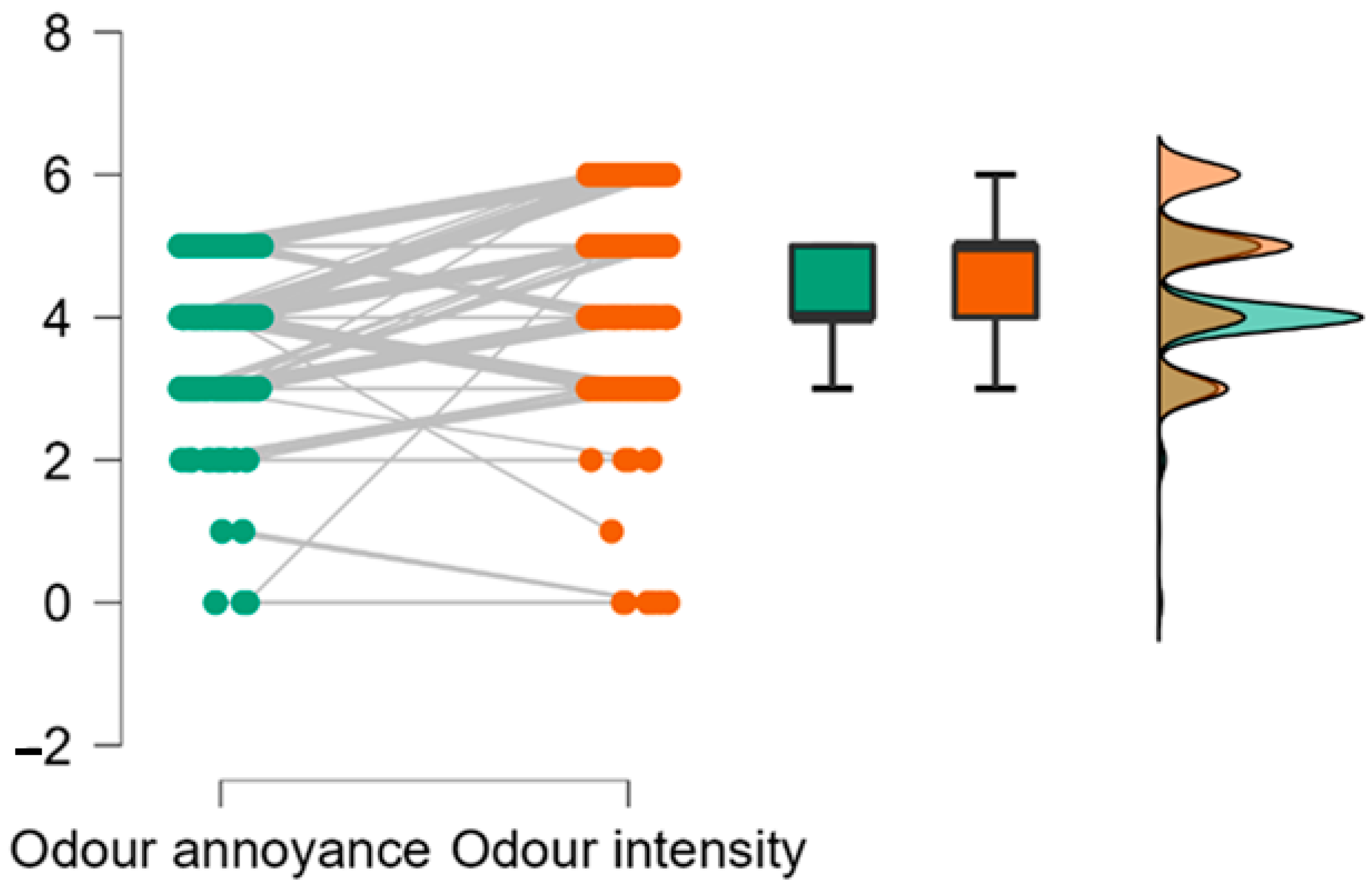

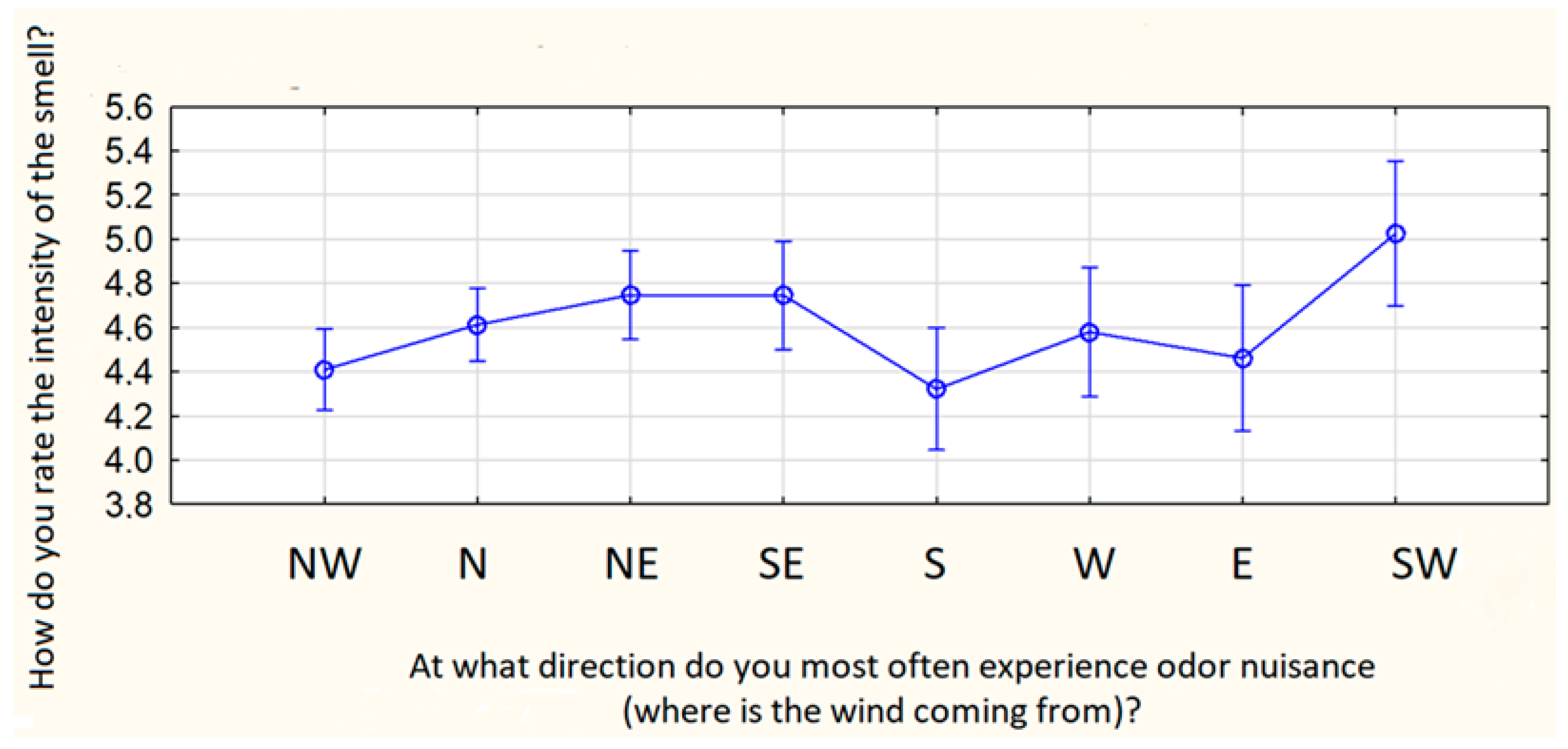
| No. | Question | Answer 1 | Answer 2 | Answer 3 | Answer 4 | Answer 5 | Answer 6 | Answer 7 | Answer 8 |
|---|---|---|---|---|---|---|---|---|---|
| 1. | Do you have an odour nuisance in Płock or its surroundings? | YES | NO | - | - | - | - | - | - |
| 2. | In which area of Płock or the surrounding village do you feel an odour nuisance? Enter the street name in Płock or the name of the neighbouring villages. | OPEN ANSWER | |||||||
| 3. | At what time of day/night do you feel the odour nuisance? You can tick more than one answer. | 12:00 a.m.–3:00 a.m. | 3:00 a.m.–6:00 a.m. | 6:00 a.m.–9:00 a.m. | 9:00–12:00 p.m. | 12:00 p.m.–3:00 p.m. | 3:00 p.m.–6:00 p.m. | 6:00 p.m.–9:00 p.m. | 9:00 p.m.–12:00 a.m. |
| 4. | How to estimate the intensity of the perceived fragrance? | I do not feel the odour | Very weak | Weak | Clearly | Strong | Very strong | Extremely strong | - |
| 5. | How do you assess the hedonic quality of the perceived fragrance? | Unpleasant | Indifferent | Pleasant | - | - | - | - | - |
| 6. | How do you estimate the intensity of the odour nuisance? | No odour | No nuisance | Small nuisance | Nuisance | Large nuisance | Extreme nuisance | - | - |
| 7. | Can you determine what is causing your odour nuisance? | OPEN ANSWER | |||||||
| 8. | In which wind direction do you most often experience an odour nuisance? | N | NE | E | SE | S | SW | W | NW |
| 9. | How often do you experience odour nuisance in Płock or near Płock? | Never | At least once a month | At least once a week | At least once a day | Almost constantly | - | - | - |
| 10. | Have you ever complained about an odour nuisance? | YES | NO | ||||||
| 11. | If you have complained about odour nuisance, please write to whom. | OPEN ANSWER | |||||||
| Odour Annoyance | Odour Intensity | |||||||||||||||
|---|---|---|---|---|---|---|---|---|---|---|---|---|---|---|---|---|
| E | N | NE | NW | S | SE | SW | W | E | N | NE | NW | S | SE | SW | W | |
| Valid | 39 | 155 | 107 | 127 | 56 | 71 | 40 | 50 | 39 | 155 | 107 | 127 | 56 | 71 | 40 | 50 |
| Median | 4.00 | 4.00 | 4.00 | 4.00 | 4.00 | 4.00 | 4.00 | 4.00 | 5.00 | 5.00 | 5.00 | 4.00 | 4.00 | 5.00 | 5.00 | 5.00 |
| Mean | 3.87 | 4.07 | 4.20 | 4.04 | 4.00 | 4.21 | 4.25 | 4.06 | 4.46 | 4.61 | 4.75 | 4.40 | 4.32 | 4.74 | 5.02 | 4.58 |
| SD | 0.80 | 0.74 | 0.72 | 0.72 | 0.76 | 0.67 | 0.67 | 0.71 | 1.21 | 1.03 | 1.15 | 1.04 | 1.01 | 1.09 | 0.73 | 0.99 |
| Min. | 1.00 | 0.00 | 2.00 | 2.00 | 2.00 | 3.00 | 2.00 | 2.00 | 0.00 | 3.00 | 1.00 | 2.00 | 3.00 | 3.00 | 3.00 | 3.00 |
| Max. | 5.00 | 5.00 | 5.00 | 5.00 | 5.00 | 5.00 | 5.00 | 5.00 | 6.00 | 6.00 | 6.00 | 6.00 | 6.00 | 6.00 | 6.00 | 6.00 |
| How Often Do You Experience Odour Nuisance? | Annoyance | Frequency | Percent |
|---|---|---|---|
| At least once a day | 3 | 9 | 6.12 |
| 4 | 90 | 61.2 | |
| 5 | 48 | 32.6 | |
| Total | 147 | 100.0 | |
| At least once a month | 2 | 6 | 7.50 |
| 3 | 28 | 35.0 | |
| 4 | 43 | 53.7 | |
| 5 | 3 | 3.75 | |
| Total | 80 | 100.0 | |
| At least once a week | 0 | 1 | 0.249 |
| 2 | 8 | 1.99 | |
| 3 | 78 | 19.4 | |
| 4 | 238 | 59.3 | |
| 5 | 76 | 18.9 | |
| Total | 401 | 100.0 | |
| Never | 0 | 4 | 66.6 |
| 1 | 2 | 33.3 | |
| Total | 6 | 100.0 | |
| Almost always | 3 | 9 | 5.84 |
| 4 | 58 | 37.6 | |
| 5 | 87 | 56.4 | |
| Total | 154 | 100.0 |
| Descriptives—Odour Annoyance | |||
| Wind Direction | Mean | SD | N |
| E | 3.872 | 0.801 | 39 |
| N | 4.065 | 0.744 | 155 |
| NE | 4.196 | 0.720 | 107 |
| NW | 4.039 | 0.717 | 127 |
| S | 4.000 | 0.763 | 56 |
| SE | 4.211 | 0.674 | 71 |
| SW | 4.250 | 0.670 | 40 |
| W | 4.060 | 0.712 | 50 |
| Descriptives—Odour Intensity | |||
| Wind direction | Mean | SD | N |
| E | 4.462 | 1.211 | 39 |
| N | 4.613 | 1.034 | 155 |
| NE | 4.748 | 1.150 | 107 |
| NW | 4.409 | 1.042 | 127 |
| S | 4.321 | 1.011 | 56 |
| SE | 4.746 | 1.092 | 71 |
| SW | 5.025 | 0.733 | 40 |
| W | 4.580 | 0.992 | 50 |
Disclaimer/Publisher’s Note: The statements, opinions and data contained in all publications are solely those of the individual author(s) and contributor(s) and not of MDPI and/or the editor(s). MDPI and/or the editor(s) disclaim responsibility for any injury to people or property resulting from any ideas, methods, instructions or products referred to in the content. |
© 2024 by the authors. Licensee MDPI, Basel, Switzerland. This article is an open access article distributed under the terms and conditions of the Creative Commons Attribution (CC BY) license (https://creativecommons.org/licenses/by/4.0/).
Share and Cite
Wiśniewska, M.; Szyłak-Szydłowski, M. The Impact of Objects with a Potential Odour Nuisance on the Life Comfort of the Urban Agglomeration Inhabitants. Appl. Sci. 2024, 14, 10708. https://doi.org/10.3390/app142210708
Wiśniewska M, Szyłak-Szydłowski M. The Impact of Objects with a Potential Odour Nuisance on the Life Comfort of the Urban Agglomeration Inhabitants. Applied Sciences. 2024; 14(22):10708. https://doi.org/10.3390/app142210708
Chicago/Turabian StyleWiśniewska, Marta, and Mirosław Szyłak-Szydłowski. 2024. "The Impact of Objects with a Potential Odour Nuisance on the Life Comfort of the Urban Agglomeration Inhabitants" Applied Sciences 14, no. 22: 10708. https://doi.org/10.3390/app142210708
APA StyleWiśniewska, M., & Szyłak-Szydłowski, M. (2024). The Impact of Objects with a Potential Odour Nuisance on the Life Comfort of the Urban Agglomeration Inhabitants. Applied Sciences, 14(22), 10708. https://doi.org/10.3390/app142210708








